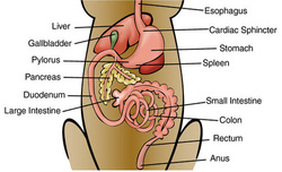Digestive System
Since a Giant Panda is technically a carnivore, their digestive system is closer to a carnivores, even though they eat like an herbivore. Because of this, most of the food they eat is passed as waste. To make up for the lost nutrients, they eat a relatively large amount of food: 20-40 pounds of bamboo a day. To be able to eat this much, they spend about 10-16 hours a day either foraging for food or eating.
Feeding Adaptations
Giant Pandas usually eat while sitting upright, resembling the position of a human sitting on the ground. This position leaves the front paws open to hold food. Their "thumb", which is actually an elongated wrist bone, aids in gripping bamboo. Giant Pandas also have very strong teeth and jaws in order to chew the tough bamboo that is nearly 100% of their diet.
Since a Giant Panda is technically a carnivore, their digestive system is closer to a carnivores, even though they eat like an herbivore. Because of this, most of the food they eat is passed as waste. To make up for the lost nutrients, they eat a relatively large amount of food: 20-40 pounds of bamboo a day. To be able to eat this much, they spend about 10-16 hours a day either foraging for food or eating.
Feeding Adaptations
Giant Pandas usually eat while sitting upright, resembling the position of a human sitting on the ground. This position leaves the front paws open to hold food. Their "thumb", which is actually an elongated wrist bone, aids in gripping bamboo. Giant Pandas also have very strong teeth and jaws in order to chew the tough bamboo that is nearly 100% of their diet.


